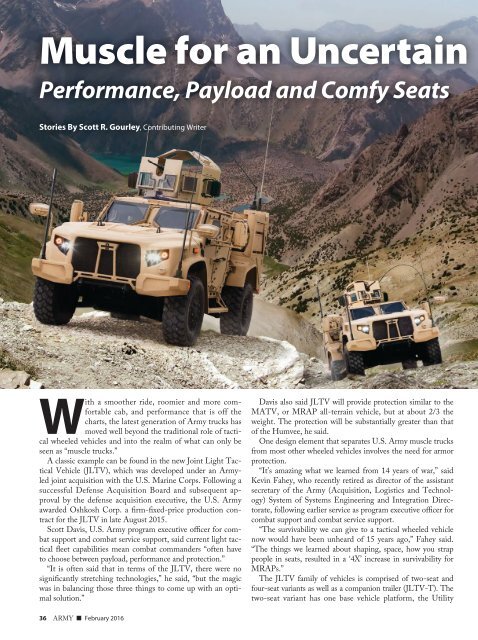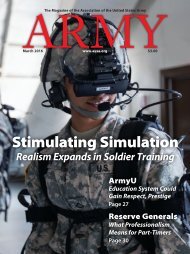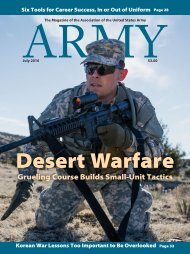Army - Kicking Tires On Jltv
You also want an ePaper? Increase the reach of your titles
YUMPU automatically turns print PDFs into web optimized ePapers that Google loves.
Muscle for an Uncertain<br />
Performance, Payload and Comfy Seats<br />
Stories By Scott R. Gourley, Contributing Writer<br />
With a smoother ride, roomier and more comfortable<br />
cab, and performance that is off the<br />
charts, the latest generation of <strong>Army</strong> trucks has<br />
moved well beyond the traditional role of tactical<br />
wheeled vehicles and into the realm of what can only be<br />
seen as “muscle trucks.”<br />
A classic example can be found in the new Joint Light Tactical<br />
Vehicle (JLTV), which was developed under an <strong>Army</strong>led<br />
joint acquisition with the U.S. Marine Corps. Following a<br />
successful Defense Acquisition Board and subsequent approval<br />
by the defense acquisition executive, the U.S. <strong>Army</strong><br />
awarded Oshkosh Corp. a firm-fixed-price production contract<br />
for the JLTV in late August 2015.<br />
Scott Davis, U.S. <strong>Army</strong> program executive officer for combat<br />
support and combat service support, said current light tactical<br />
fleet capabilities mean combat commanders “often have<br />
to choose between payload, performance and protection.”<br />
“It is often said that in terms of the JLTV, there were no<br />
significantly stretching technologies,” he said, “but the magic<br />
was in balancing those three things to come up with an optimal<br />
solution.”<br />
Davis also said JLTV will provide protection similar to the<br />
MATV, or MRAP all-terrain vehicle, but at about 2/3 the<br />
weight. The protection will be substantially greater than that<br />
of the Humvee, he said.<br />
<strong>On</strong>e design element that separates U.S. <strong>Army</strong> muscle trucks<br />
from most other wheeled vehicles involves the need for armor<br />
protection.<br />
“It’s amazing what we learned from 14 years of war,” said<br />
Kevin Fahey, who recently retired as director of the assistant<br />
secretary of the <strong>Army</strong> (Acquisition, Logistics and Technology)<br />
System of Systems Engineering and Integration Directorate,<br />
following earlier service as program executive officer for<br />
combat support and combat service support.<br />
“The survivability we can give to a tactical wheeled vehicle<br />
now would have been unheard of 15 years ago,” Fahey said.<br />
“The things we learned about shaping, space, how you strap<br />
people in seats, resulted in a ‘4X’ increase in survivability for<br />
MRAPs.”<br />
The JLTV family of vehicles is comprised of two-seat and<br />
four-seat variants as well as a companion trailer (JLTV-T). The<br />
two-seat variant has one base vehicle platform, the Utility<br />
36 ARMY ■ February 2016

















